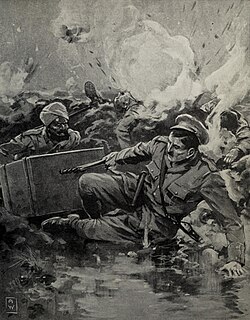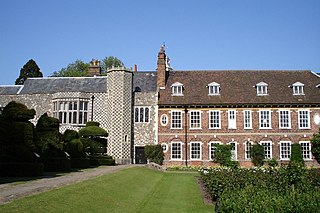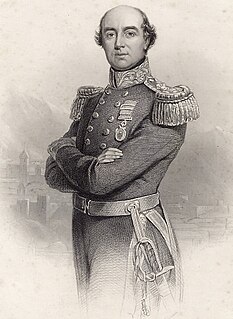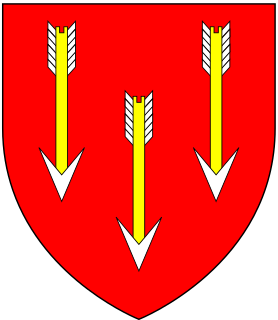
There have been three baronetcies created for persons with the surname Booth, one in the Baronetage of England and two in the Baronetage of the United Kingdom. The 1916 creation remains extant, the 1835 creation became extinct in 1896 and the 1611 baronetcy has been dormant since 1797. The senior line of the first creation was elevated to the peerage as Baron Delamer and Earl of Warrington.

There have been six baronetcies created for persons with the surname Smyth, two in the Baronetage of England, one in the Baronetage of Great Britain, one in the Baronetage of Ireland and two in the Baronetage of the United Kingdom. One creation is extant as of 2010.

There have been two Baronetcies created for persons with the surname Austen, one in the Baronetage of England and one in the Baronetage of Great Britain. Both creations are extinct.
Sir Anthony Aucher, 1st Baronet was an English politician who sat in the House of Commons in 1660. He supported the Royalist cause during the English Civil War.
There have been five baronetcies created for persons with the surname Vavasour, three in the Baronetage of England and two in the Baronetage of the United Kingdom. As of 2008 four of the creations are extinct while one is extant.

There have been twenty one baronetcies created for persons with the surname Williams, eight in the Baronetage of England, three in the Baronetage of Great Britain and ten in the Baronetage of the United Kingdom. Only six of the creations are extant as of 2017.

There have been four baronetcies created for persons with the surname Miller, two in the Baronetage of England, one in the Baronetage of Great Britain and one in the Baronetage of the United Kingdom. Two of the creations are extant as of 2008.
There have been two baronetcies created for persons with the surname Markham, one in the Baronetage of England and one in the Baronetage of the United Kingdom.

The Hales Baronetcy, is a title in the Baronetage of England. There were three Hales baronetcies. The oldest was created in 1611 for Edward Hales. He was a member of a Kent family. The second was created in 1660 for Robert Hales, MP for Hythe 1659, also of a Kent family. The third was created in 1660 for John Hales of Coventry, co. Warwick.
There have been four baronetcies created for persons with the surname Temple, two in the Baronetage of England, one in the Baronetage of Nova Scotia and one in the Baronetage of the United Kingdom.
Three baronetcies were created for persons with the surname D'Oyly, two in the Baronetage of England and one in the Baronetage of the United Kingdom. One creation is extant as of 2008.
The Peacocke Baronetcy, of Grange in the County of Limerick and of Barntinck in the County of Clare, was a title in the Baronetage of the United Kingdom. It was created on 24 December 1802 for Sir Joseph Peacocke, of Grange, County Limerick. Sir Joseph was the son of George Peacocke Esq. and his wife Mary (Levett) Peacocke, daughter of Joseph Levett, Alderman, of Cork, Ireland. The title became extinct on the death of his grandson, the third Baronet, in 1876.
The Baronetcy of Goodricke of Ribston was created in the Baronetage of England by King Charles I on 14 August 1641 for his loyal supporter John Goodricke of Ribston, Yorkshire. He represented Yorkshire in the Cavalier Parliament from 1661 to his death.

There have been five baronetcies created for members of the old established family of Peyton of Peyton Hall in the parish of Boxford in Suffolk, all of whom were descended from Sir Robert Peyton (d.1518) of Isleham in Cambridgeshire, grandson and heir of Thomas Peyton (1418–1484) of Isleham, twice Sheriff of Cambridgeshire and Huntingdonshire, in 1443 and 1453. All the baronetcies are extinct.
There have been four creations of baronetcies with the surname Baker. They are listed in order of creation.

Sir John Cutler, 1st Baronet (1603–1693) was an English grocer, financier and Member of Parliament.
There have been two baronetcies- both extinct- granted to the Willises of Fen Ditton, both in the Baronetage of England.

The Lawrence, later WoollastonBaronetcy, of Loseby in the County of Leicester, was a title in the baronetage of Great Britain. It was created on 17 January 1748 for Edward Lawrence Esq.,, with remainder to his great-nephew, Isaac Woollaston (d.1750) of Lowesby Hall, Leicestershire. Lawrence was MP for Stockbridge. He died in 1749 and was succeeded according to the special remainder by his great-nephew, Isaac Woollaston, the second baronet. He was the grandson of Josiah Woollaston (1652–1689) by his wife Elizabeth Lawrence, sister of the first baronet. The title became extinct on the death of the second baronet's son, the third baronet, who died as a child in 1756.
The Fenton Baronetcy, of Mitchelstown in the County of Cork, was a title in the Baronetage of Ireland. It was created on 22 July 1661 for Maurice Fenton. The baronetcy became extinct on 17 March 1670, with the death of his son William Fenton.
Eland Mossom, Esq. M.P. was a lawyer, recorder of the City of Kilkenny, and representative in the Parliament of Ireland for the Borough of St Canice in Irishtown. He was the eldest son of Dean of Kilkenny Robert Mossom. He resided at Mount Eland, near Ballyraggett.









